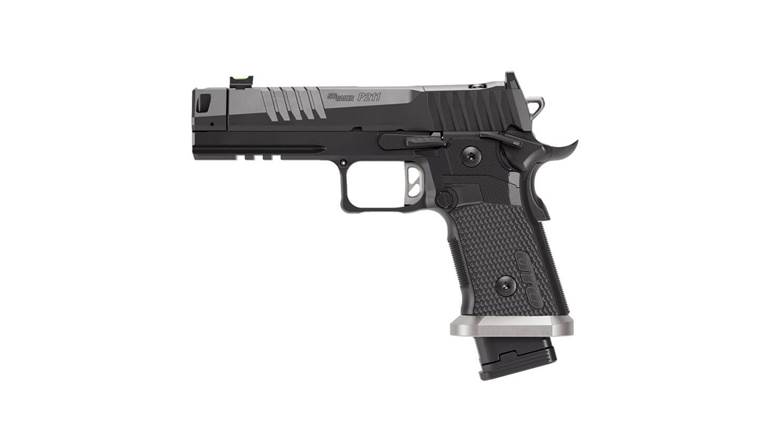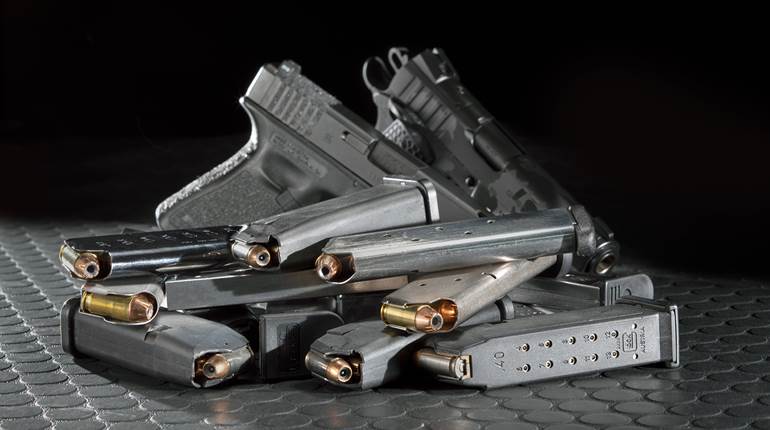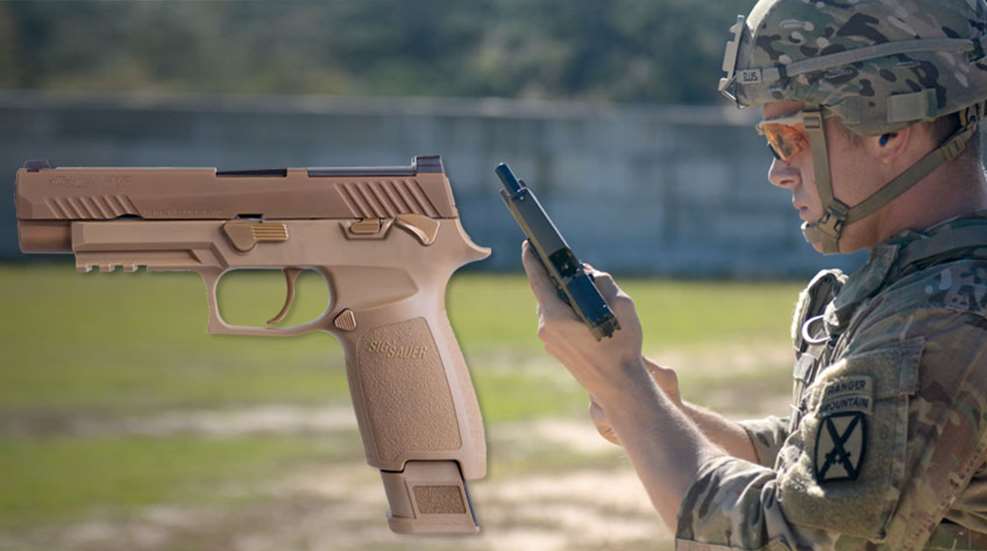
Soldiers, including Army 1st Lt. Spencer Ellis of the 10th Mountain Division, are being issued M17s. This early-production U.S. M17—denoted by its flat dark earth controls—is fitted with a 21-round-capacity magazine (l.). The Army has since agreed to black controls to speed delivery of the guns.
In the words of Juan Sanchez Villa-Lobos Ramirez in the cult classic film “Highlander,” “There can be only one.” On Jan. 28, 2017, we learned the identity of the “one” when the U.S. Army’s Project Executive Office (PEO) Soldier announced the selection of the Modular Handgun System (MHS). The winner of the long and somewhat convoluted trial was SIG Sauer—with a pair of guns based upon its striker-fired P320, the 4.7"-barreled XM17 and the compact, 3.9"-barreled XM18. Those designations have since changed to the U.S. M17 and M18, respectively. The plan is to procure 421,000 guns, with the Army taking 195,000, the Marines 35,000, the Air Force 130,000 and the Navy 61,000.
Just in case you don’t think this is a big deal, remember the U.S. military adopted its first semi-automatic handgun in 1911, modified it a little bit in the 1920s as the M1911-A1, and that gun served as the standard U.S. military sidearm until 1985. That’s when the U.S. Army embraced the 9x19 mm NATO cartridge with the adoption of the M9, which was based on the Beretta Model 92FS. Changing the general-issue pistol only happens once a generation, actually less than that. The selection of the M17 and the M18 in no way reflects poorly on the continued service of Beretta and the approximately 600,000 M9s acquired by the U.S. military—in fact, new M9s are still being delivered.
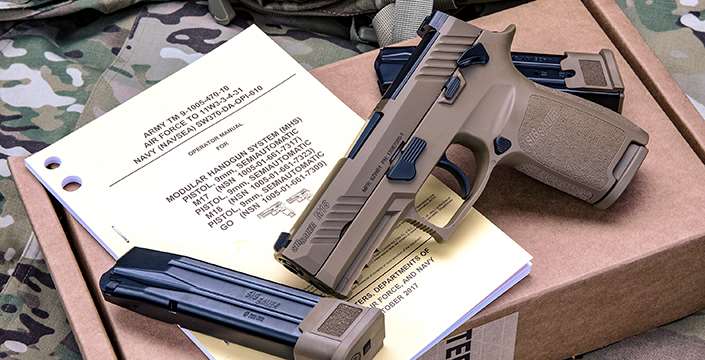
The Process
This whole process began with a series of four somewhat-confusing informational meetings, called “Industry Days,” followed by an open-ended Request For Proposal (RFP) released on Sept. 2, 2015, by Project Manager Soldier Weapons. “The XM17 will consist of a new handgun, ammunition, supporting accessories, and spare parts. The XM17 procurement is planned as a Full & Open Competition (F&OC) acquisition seeking a system solution that will provide Warfighters with a best-value system that features increased lethality, increased accuracy, improved ergonomics, and a higher degree of reliability/durability over legacy handgun systems.”
What confused everyone was that it seemed like the Army didn’t know what it wanted, leaving both chambering and configuration open to the entrants. This fueled speculation that the Army was going back to .45 ACP or even to .40 S&W or something else. It wasn’t.
According to the RFP, some things the MHS needed to do were: fit more soldiers’ hands (90 percent of them); hit a 4" target at 35 meters 90 percent of the time; be flat dark earth; have a threaded muzzle for a suppressor; have a rail that allows lights and lasers; have a 35,000-round service life; and fire 10,000 mean rounds between failures. And it would be a two-gun deal—a full-size model and a compact for investigators and others.
Here is what the Army wanted: “The offeror shall provide in the operator manual a detailed description of the ergonomic aspects of their pistol. This manual shall clearly detail the steps required to make adjustments to trigger reach, pistol grip or any other adjustable components to fit the range of users expected to utilize the Modular Handgun System. Configurability will be evaluated based on ease of reconfiguration, ergonomic accommodation and effectiveness for the 5th to 95th percentile warfighter. The manual should also depict reconfiguration options and instructions to adjust controls from right- to left-handed use at the operator level.”
The Army made it clear: The guns had to fit 90 percent of soldiers’ hands. Period. “Upon receipt of hardware submission, inspections will be conducted to ensure that the Modular Handgun System candidate has an integrated rail, an external safety mechanism, adjustability for ergonomics (by means of grip inserts, grip panels, front- or backstraps, different triggers, or other means) and be other than single action only. Submissions without these features will not be considered for evaluation.” (Emphasis mine).
The Contenders
Although just about every gun company thought about entering the MHS process, the contenders were the Beretta APX, CZ P-07 and P-09, a variant of FN America’s FN-S Compact (which became the FN 509), Glock G19 (with the addition of a thumb safety), a Heckler & Koch VP9, a version of Smith & Wesson’s M&P9, the Sphinx SDP, the STI/Detonics Defense STX and, finally, the SIG Sauer compact and full-size guns based on the P320. Smith and STI withdrew voluntarily. In the end, it seems the Army was quite serious about modularity.
SIG Sauer was confident its entrant had a pretty good shot. “The extensive internal testing and hundreds of thousands of rounds fired through the platform gave us the confidence in its durability and reliability,” said SIG Sauer Design Engineer Sean Toner. “We felt strongly that the platform would meet or exceed the rigors of the program’s testing requirements. Additionally we viewed the modularity of the P320 as an added benefit that ensured all end users would feel comfortable with fit and performance.”
“From our records, well over 2 million rounds of ammunition have been put through the MHS (M17/M18) in the past two-and-half to three years during testing (inclusive of bid sample testing and down-selection),” said SIG’s Defense Strategies Group Program Manager Gabe Bailey. “Additionally, during every Lot Acceptance Test (LAT), SIG Sauer is required to test a certain number of handguns (based on lot size) to 12,000 rounds each. This normally equates to approximately 36,000 to 60,000 rounds per lot of handguns produced.”
Toner, who was team lead on the project, summed up with, “The MHS contract has been the most challenging, exciting and rewarding opportunity that we could have had. It is an honor that the pistol our team designed has been chosen for the most prestigious award we could imagine.”
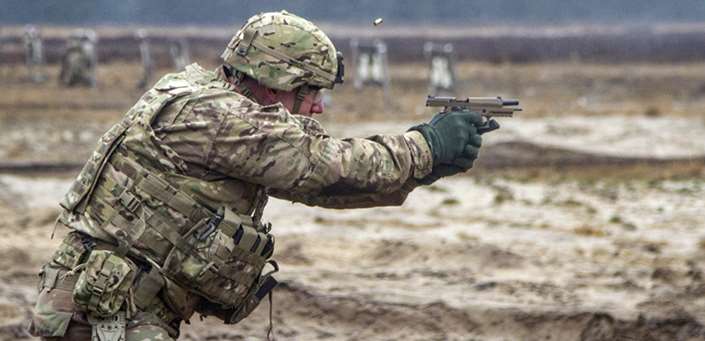
Credit Cards & “Double-Ejections”
The process was not without hiccups and controversy. While moving at breakneck speed for a Dept. of Defense (DoD) acquisition, the time and cost led Army Chief of Staff Gen. Mark Milley to express frustration to Fox News by saying “You give me $17 million on the credit card, I’ll call Cabela’s tonight, and I’ll outfit every soldier, sailor, airman and Marine with a pistol, and I’ll get a discount on it for bulk buys.”
Not long after the contract was awarded, Glock—which didn’t win—filed a protest with the Government Accounting Office (GAO). In June 2017, “GAO denied the challenge to the interpretation of the solicitation, finding that the RFP allowed the Army to make only one award, although up to three awards were permitted by the RFP’s terms. GAO also denied the challenge to the Army’s evaluation of Glock’s proposal on the basis that any errors did not prejudice Glock in the competition.”
Then there was the Sharknado-like blogosphere P320 feeding frenzy in August 2017—one that had nothing to do with the XM17—regarding a very specific and rare “negative-30-degree drop” impact that could allow some P320 pistols to fire. SIG Sauer did extensive testing, got out in front of it and announced a “Voluntary Upgrade Program” on the commercial side.
The XM17 version of the P320 with the original fire control components had already gone through Army testing—including drop testing—when SIG requested to make a change to the trigger that eliminated the so-called “double-click” improving the pull without increasing the weight. Long before the P320 furor erupted, SIG had worked with the Army, instituting an Engineering Proposal Change, which involved 30 percent lighter fire control components, thus, incidentally, eliminating the potential drop issue.
Just when they thought it was safe to go back in the water, the Pentagon’s Office of the Director of Operation Test and Evaluations (DOT&E), which reviews and analyzes all DoD acquisition programs, dropped a report in January 2018 that made it sound like the guns simply didn’t work. There were two triggers that splintered early in testing, which SIG immediately addressed. There were “double-ejections” with XM1152 ball rounds. I’m still confused by that term, but suspect it is a live round following an ejected case out of the ejection port. With XM1152 FMJ and XM1153 JHP loads, the guns met their mean rounds between failure thresholds, but not that of mean rounds between stoppages. Most of the stoppages in the DOT&E report—60 of 120 with the XM17 and 63 of 85 for the XM18—were failures of the slide to lock back on an empty magazine. It turns out showing soldiers how to properly hold the pistol, without pushing down on the slide lock, made all the difference. While the media again thought the sky was falling, both POE Soldier and SIG Sauer remained calm as fixes for the issues had already been discovered in testing—that’s what testing is for—and were resolved before the problems were reported by DOT&E.
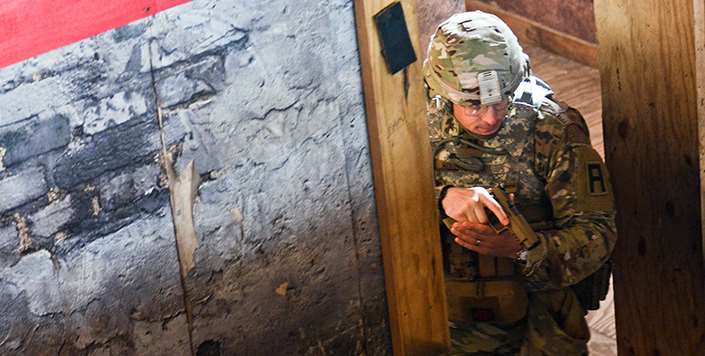
In The Hands Of The Troops
In the words of Lt. Col. Martin O’Donnell of the 101st Airborne Division, “Christmas came early for the 101st.” And it came in the form of the first 2,000 or so M17s issued at Fort Campbell, Ky., in November 2017. Not long after the first troops received the guns, I attended a meeting at Ft. Belvoir, Va., chaired by then Project Manager Soldier Weapons, Lt. Col. Steven Power, and on the civilian side Daryl A. Easlick, Deputy, Lethality Branch, Maneuver Center of Excellence. (How’s that for a title of a very serious man with a very serious job?) And on the conference call were soldiers from the 101st who had actually been issued the gun—and they liked it. A lot. With only a single, trigger-pull length and weight to train, you get better results more quickly than with a traditional double-action/single-action pistol. For soldiers, that means increased capability and increased lethality when they close with and destroy the enemy.
The adoption of the MHS represented a sea change in the Army as to whom pistols are issued. Most soldiers carry M4s, now many will get M17s in addition to their carbines. The Army calls it “dual-arming policy,” and M17s are integrated at the squad level. There are times, when crawling in a dark hole or going up a ladder in urban operations, a handgun is, well, handier.
Master Gunner of the 101st Airborne Division SFC Andrew Flynn, who was part of the Lethality Working Group said, “This is an excellent weapon system for soldiers … we will be providing it to the team leader and above. Soldiers who have never had one will be able to have this weapon system in their hands prior to this fielding and will be able to be more lethal with it with minimal training requirements.”
Soldiers of the 101st quickly took advantage of one of the principal design features, and that is that the “gun” is a chassis, and the grip frame itself is easily replaceable. There are three different grips—small, medium and large. According to the soldiers themselves, the “large” results in a grip that’s just a little larger than the M9, the medium is a little smaller and the small is, well, a lot smaller.
Based on the number and sizes of gloves issued by the Army, Lt. Col. Power estimated probably 90 percent of soldiers will stick with the medium grip. “I shot my personal weapon with the medium grip,” said 1st Lt. Andrew Borer, a platoon leader with Charlie Co., 506th Infantry Regt., then he swapped it for the small. “I found the small fit better, as it allowed more control.”
Completing The System
Just nine months after the contract was awarded, SIG had delivered the first 5,100 guns to the Army’s 101st and 82nd Airborne Divisions. “By March 2019, approximately 27,000 guns—22,000 M17s and 5,000 M18s—had been delivered, with the Army, Navy, Air Force and Marine Corps all receiving guns,” said SIG Sauer’s Gabe Bailey. “The Navy and Marine Corps have received low quantities for training, demonstration and evaluation.” Differences between the commercial guns and the U.S. M17s include the markings, springs and corrosion-protective finishes. To get more M17s delivered, the Army has even allowed the controls to be black rather than FDE.
Much of the attention has been focused on the M17, but the M18 is being manufactured and issued as well. “Based upon our understanding, within the Army, military police (MPs) and criminal investigative division (CID) agents will receive the M18,” Bailey said. Unlike the Army, “All other services intend to field the M18 as the standard sidearm.”
Everything in the Army is a system, and while there has been much focus on the gun and ammunition, there are other pieces to the MHS. The first holster for the M17 and M18 was announced in 2017, and it was a variant of the Safariland 7TS holster with both ALS and SLS locking systems. Atlantic Diving Supply was awarded a $49 million contract to supply the holsters last July. In January, LaserMax Defense was selected as the Pistol Aiming Light (PAil) to go on the M17’s rail section to the tune of 20,000 units. It combines a white light along with a near-infrared laser and a near-infrared illuminator—the Army has already selected a holster for it. The original MHS RFP called for suppressor capability, although no contract has been announced. I’m told they are working on it.
Meanwhile, the M17 is being issued to and used by soldiers. On this month’s cover is a member of the 3rd Cavalry Regt. before taking part in a night-fire exercise near the Iraq-Syria border on June 21, 2018. As this was being written a Tweet came in from PEO Soldier showing a very competent looking Lt. Col. Bryan J. Dodd of the 1st Armored Brigade Combat Team firing the M17 in Trzebinia, Poland, during a live-fire exercise. In the company of soldiers—that’s where you will find the M17.
Additional Reading:
Tested: SIG Sauer P320 M17 Pistol
M1152 & M1153: The Army's New 9 mm Luger Loads
Known But to God: The Unknown Soldier and the U.S.S. Olympia













